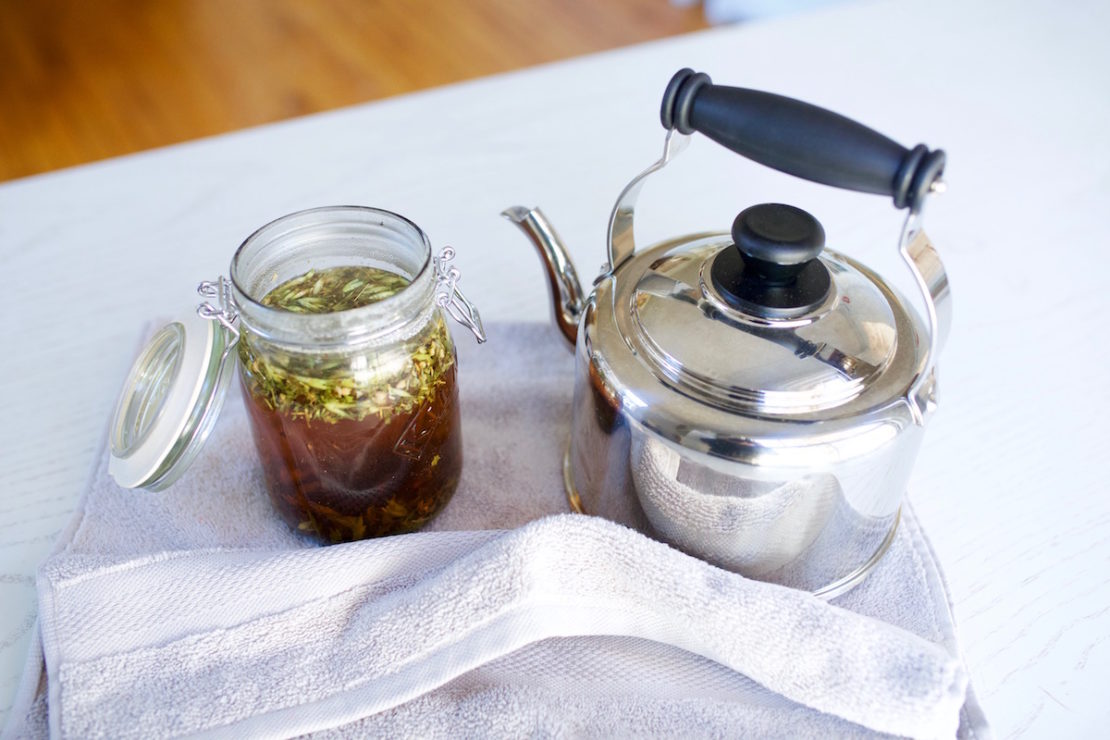
How Does Hot Water Temperature Affect The Nutritional Content Of Herbs?
When it comes to health and wellness, herbs can be one of our greatest allies. Herbal tea is a go-to for soothing common ailments like cold and flu symptoms, while herbal infusions are beloved as nature’s “vitamin supplement.”
When it comes to steeping nutritional herbs for vitamins and minerals, most of us turn to a whistling kettle of boiled water. The idea is that hot water plus high-vitamin herbs equals a high-vitamin tea.
Is this long-held belief actually true, though?
In some cases, science shows that hotter isn’t always better. Before you turn on the stove to make a teapot of herbal infusion, take a look at how heat can impact our favorite herb-sourced vitamins and minerals—affecting the nutritional content of herbs.
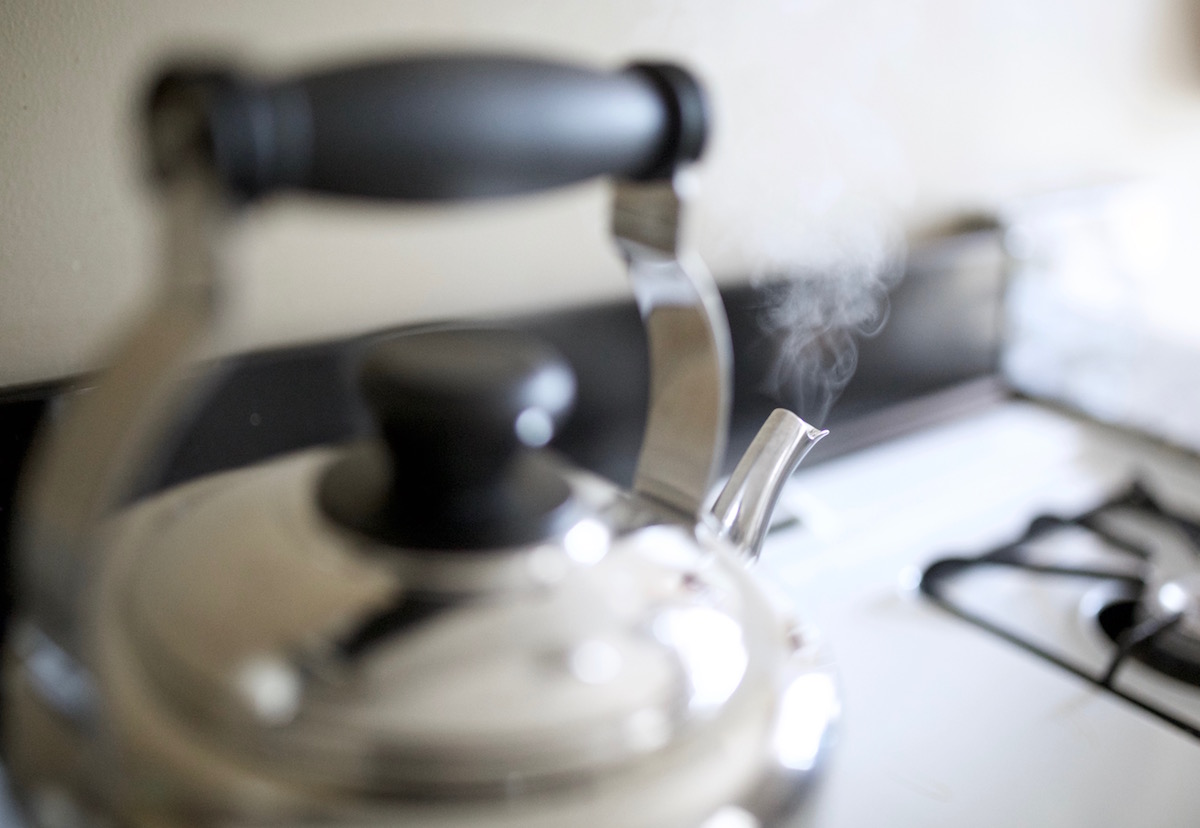
The Universal Solvent: Water
Water is not only cheap and, for the most part, readily available, but it’s considered the universal solvent—having a more substantial range when it comes to extracting plant chemicals than any other known liquid (Green, 2000).
When it comes to using nutritional herbs for their vitamin and mineral content, water is thought to be the best way to extract these nutrients.
Below, we will look at how heat affects the nutritional content of herbs, exploring its effect on both their vitamin and mineral content.
Heat And Its Effect on Vitamin Content
B Vitamins
Stability varies for vitamins B1, B2, B3, B6, B9, and B12. They’re all water-soluble and can be extracted by water, so that’s great news for tea lovers and infusion fiends.
One study explored vitamin B loss in boiled milk. The findings revealed that fifteen minutes of boiling resulted in a decrease in content of vitamins B1, B2, B3, B6, and B9 ranging from 24% decrease for B6 to 36% decrease for B9 (Asadullah, 2010). That actually doesn’t sound too bad given that this milk was boiled for fifteen minutes, but if you’re aiming to preserve as much of herbal-sourced B vitamins as possible for sipping, then you may want to give your steaming kettle a few minutes to cool down before pouring it over your tea bag.
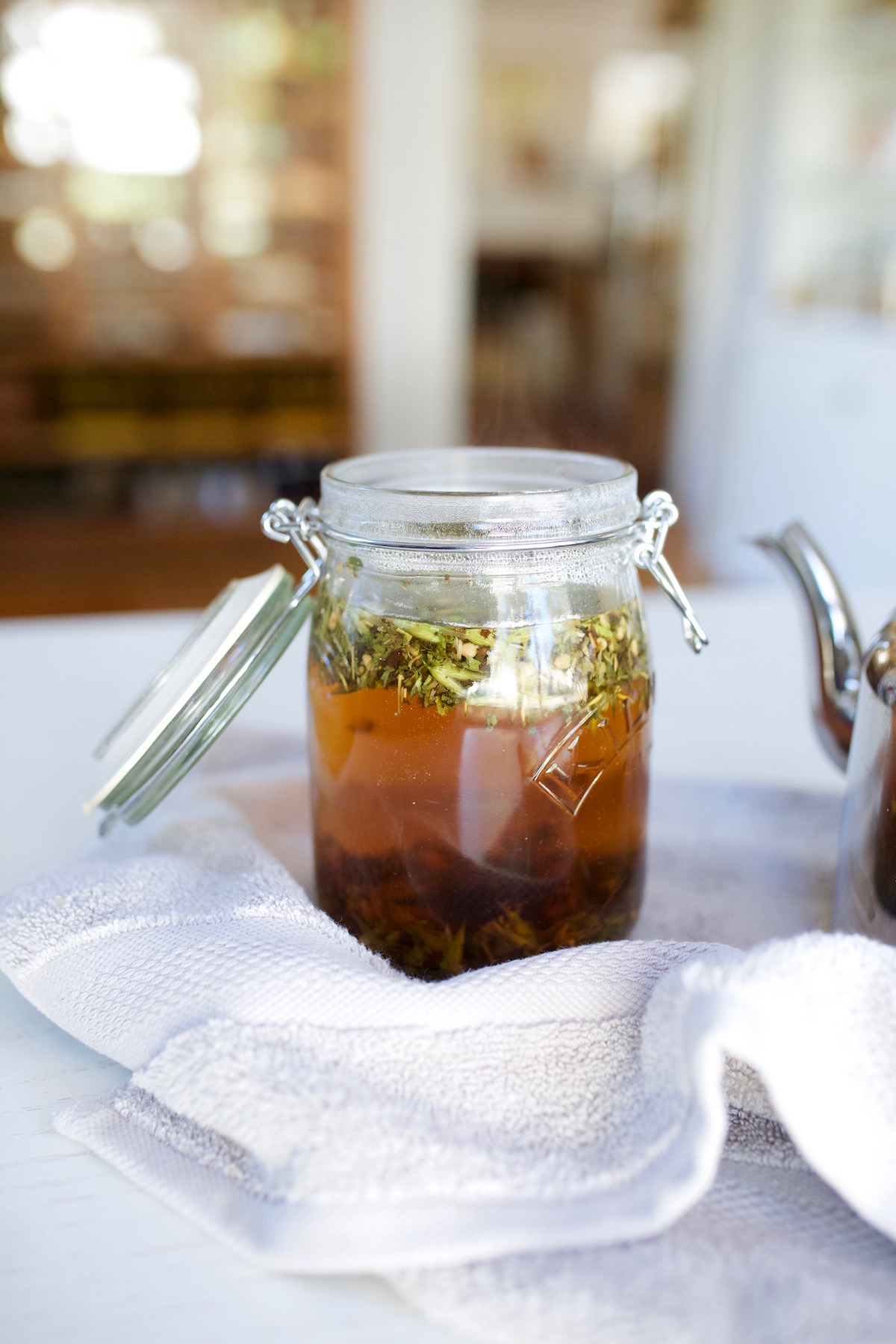
Here are some herbs that are good sources of B vitamins:
Herbal Sources of B Vitamins
| Vitamin B1 (Thiamine) | Alfalfa, bladderwrack, burdock root, catnip, cayenne, chamomile, chickweed, eyebright, fennel seed, fenugreek, hops, nettle, oat straw, parsley, peppermint, raspberry leaf, red clover, rose hips, sage, yarrow, and yellow dock. |
| Vitamin B2 (Riboflavin) | Alfalfa, bladderwrack, burdock root, catnip, cayenne, chamomile, chickweed, eyebright, fennel seed, fenugreek, ginseng, hops, horsetail, mullein, nettle, oat straw, parsley, peppermint, raspberry leaf, red clover, rose hips, sage, and yellow dock. |
| Vitamin B3 (Niacin) | Alfalfa, burdock root, catnip, cayenne, chamomile, chickweed, eyebright, fennel seed, hops, licorice, mullein, nettle, oat straw, parsley, peppermint, raspberry leaf, red clover, rose hips, slippery elm, and yellow dock. |
| Vitamin B6 (Pyridoxine) | Alfalfa, catnip, oat straw. |
| Vitamin B12 (Methylcobalamin) | Alfalfa, bladderwrack, hops. |
Note: The information in this chart is sourced from Prescription For Nutritional Healing by Phyllis Balch.
Vitamin C
Vitamin C is another vitamin that is soluble in water (Colorado State University, n.d.) which is great news for tea and infusion drinkers! However, you might not want to boil up any rose hips just yet. Ironically, the vitamin most often sought during times of sickness is actually the most sensitive to heat.
A 2010 study looked at the effect of heat on the vitamin C content of a number of fresh juices, including orange juice. After being heated to 40 C/104 F, the orange juice showed a vitamin C loss of 42.14% (El-Ishaq & Obirinakem, 2010).
We can get another look at the effect of heat on vitamin C from a study in which samples of broccoli, spinach, and lettuce were exposed to five minutes of heat treatment either via steaming, microwaving, or boiling. Steamed veggies lost 8.6-14.3% of vitamin C content, while microwaved veggies lost 21.2-28.1% of vitamin C content. The greatest loss was seen in boiling, with veggies losing 40.4-54.6% of their original vitamin C content (Zeng, 2013).
Obviously an herbal infusion is a bit different than cooked veggies, but regardless of preparation method, the information out there shows that heat does decrease vitamin C content. A 2012 study also showed that the higher the temperature, the faster the rate of oxidative damage occurs in vitamin C (Rahmawati & Bundjali, 2012).
Although tea lovers may be feeling a bit heartbroken by this news, all hope is not lost. Cold water infusions may be helpful. If you’re looking to preserve the vitamin C content of your herb, lower infusion temperatures can help. Nancy Phillips, in her book The Herbalist’s Way, says that a peppermint tea prepared as a cold infusion will retain more vitamin C and will have a brighter flavor than one made with hot water (Phillips, 2005).
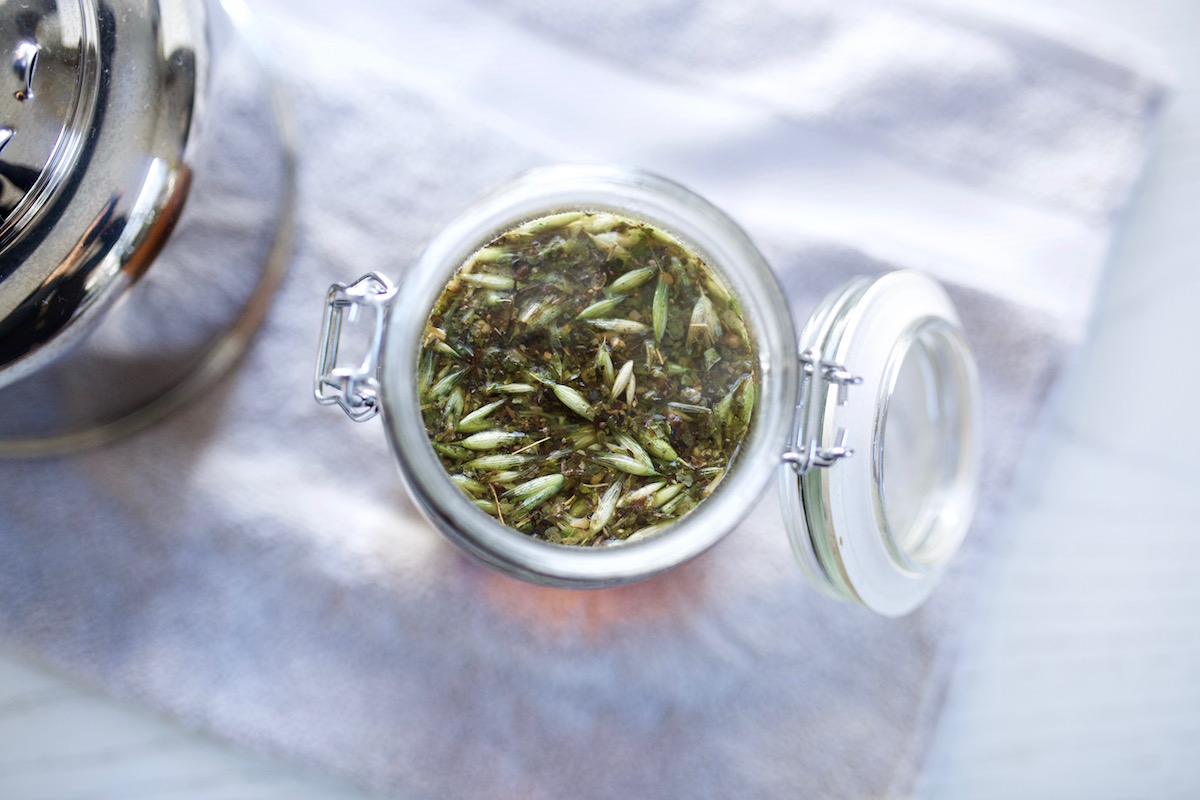
Herbal Sources of Vitamin C
| Alfalfa, burdock root, cayenne, chickweed, eyebright, fennel seed, fenugreek, hops, horsetail, kelp, mullein, nettle, oat straw, paprika, parsley, peppermint, pine needle, plantain, raspberry leaf, red clover, rose hips, skullcap, violet leaves, yarrow, and yellow dock |
Note: The information in this chart is sourced from Prescription For Nutritional Healing by Phyllis Balch.
Heat And Its Effect on Mineral Content
As we’ve seen above, vitamins can be finicky when it comes to heat. Luckily, minerals aren’t so sensitive to degradation. The minerals calcium, iron, magnesium, phosphorus, potassium, sodium, zinc, and copper aren’t impacted by heat (US Department of Agriculture, 2007). In this report, various vegetables and greens were analyzed for their mineral content after being exposed to different cooking methods. The only time mineral loss was seen was when greens or vegetables were cooked in water and the water was drained. Otherwise, mineral content was at 100%. But hold on, it gets better! The majority of dietary minerals take the form of water-soluble salts, which makes them perfect candidates for herbal infusions (Casiday & Frey, 2001).
So What’s the Answer?
So, can hot water temperatures destroy the nutritional content of herbs? In some cases, yes and in others, no. It really comes down to the specific nutrients and how stable they are in heat. When drinking herbal teas or infusions for nutritional benefits, it pays to know the nutritional content of the herbs you’re using and how heat affects them, altering your preparation techniques to fit each nutrient’s specific needs.
Happy steeping everyone!
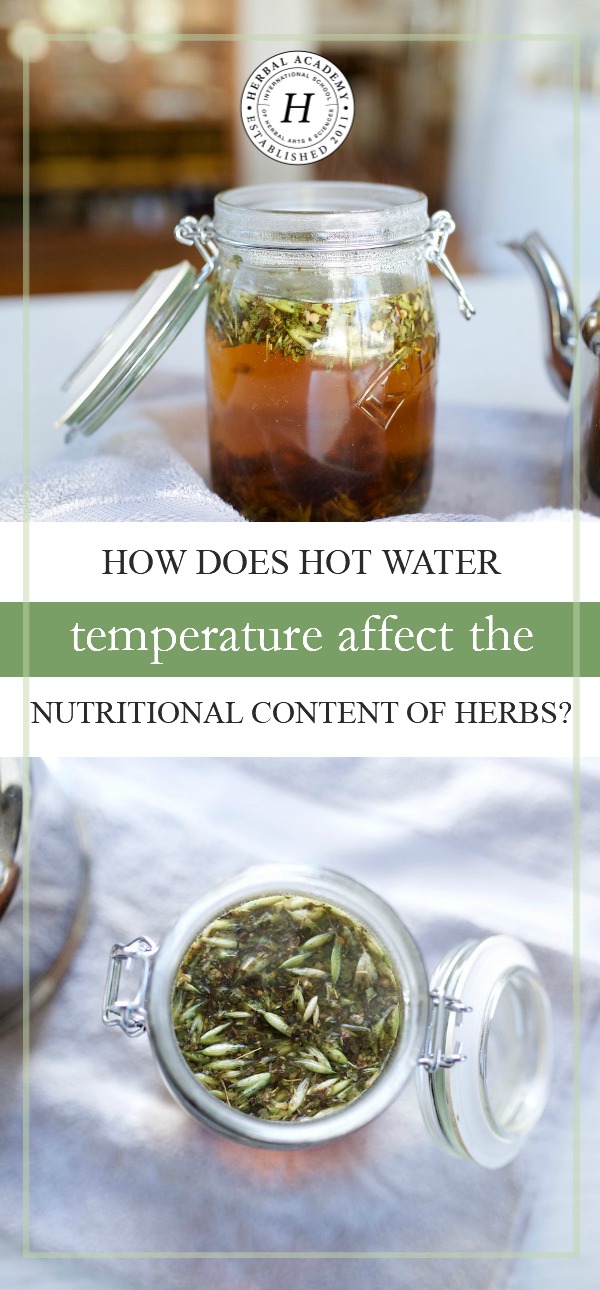
REFERENCES
Asadullah, K., Tarar, O.M., Ali, S.A., Jamil, K., Begum, A. (2010). Study to evaluate the impact of heat treatment on water soluble vitamins in milk [Abstract]. The Journal Of The Pakistan Medical Association, 60(11), 909-12. Retrieved from https://www.researchgate.net/publication/50286429_Study_to_evaluate_the_impact_of_heat_treatment_on_water_soluble_vitamins_in_milk
Balch, P. (2006). Prescription for nutritional healing. New York, NY: Penguin Group.
Casiday, R. & Frey, R. (2001). Nutrients and solubility. Retrieved from http://www.chemistry.wustl.edu/~edudev/LabTutorials/Vitamins/vitamins.html
Colorado State University. (n.d.). Water-soluble vitamins: B-complex and vitamin C. Retrieved from http://extension.colostate.edu/topic-areas/nutrition-food-safety-health/water-soluble-vitamins-b-complex-and-vitamin-c-9-312/
Council For Responsible Nutrition. (2014). Stability and shelf-life requirements for supplements. Retrieved from http://www.crn-i.ch/2014symposium/Presentations/7_Jennings.pdf
El-Ishaq, A. & Obirinakem, S. (2010). Effect of temperature and storage on vitamin C content in fruits juice. International Journal of Chemical and Biomolecular Science, 1(2),17-21. Retrieved from https://www.researchgate.net/publication/279976518_Effect_of_Temperature_and_Storage_on_Vitamin_C_Content_in_Fruits_Juice
Green, J. (2000). The herbal medicine-maker’s handbook: A home manual. New York, NY: Crossing Press.
Hrncirik, K. (2010). Stability of fat-soluble vitamins and PUFA in simulated shallow-frying. Lipid Technology, 22(5),107-9. Retrieved from http://onlinelibrary.wiley.com/doi/10.1002/lite.201000018/pdf
Phillips, N., & Phillips, M. (2005). The herbalist’s way. White River Junction, VT: Chelsea Green Publishing.
Rahmawati, S. & Bundjali, B. (2012). Kinetics of the oxidation of vitamin C. Indonesian Journal of Chemistry, 12(3),535-46. Retrieved from https://www.researchgate.net/publication/228484005_KINETICS_OF_THE_OXIDATION_OF_VITAMIN_C
U.S. Department of Agriculture (2007). USDA Table of Nutrient Retention Factors: Release 6. [Report]. Retrieved from https://www.ars.usda.gov/ARSUserFiles/80400525/Data/retn/retn06.pdf
Van Bree, I., Baetens, J.M., Samapundo, S., Devlieghere, F., Laleman, R., Vandekinderen, I., Noseda, B., Xhaferi, R., De Baets, B., De Meulenaer, B. (2012). Modeling the degradation kinetics of vitamin C in fruit juice in relation to the initial headspace oxygen concentration. Food Chemistry, 134 (1),207-14. Retrieved from http://www.sciencedirect.com/science/article/pii/S0308814612002841
Zeng, C. (2013). Effects of different cooking methods on the vitamin C content of selected vegetables. Nutrition & Food Science, 43(5),438-43. Retrieved from http://www.emeraldinsight.com/doi/abs/10.1108/NFS-11-2012-0123








